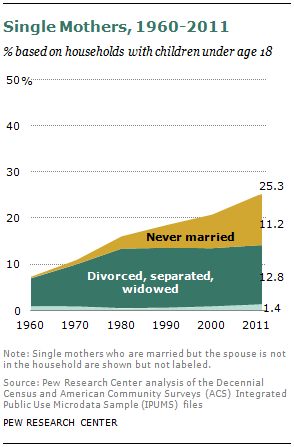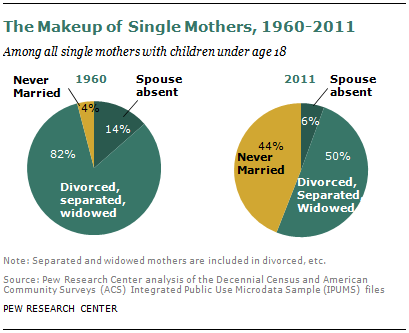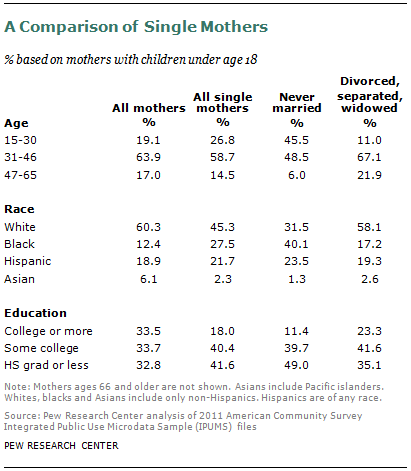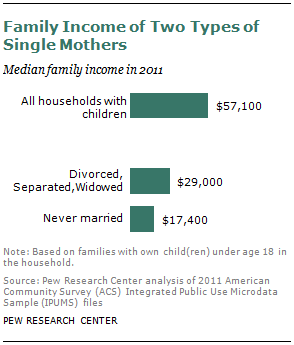
Single mothers are made up of two major groups: one consists of mothers with children from a previous marriage, and the other consists of mothers who have never been married.22 There is also a small group of mothers who are married but whose spouses are not living in the household. In the past five decades, the share of never married mothers among all families with children has increased from less than 1% to 11%. The share of mothers who are divorced, separated or widowed increased in the 1960s and 1970s and has remained relatively stable since 1980, hovering around 12% to 13% in the past three decades.
These patterns are tied to broader long-term trends in non-marital births and divorce. According to the data from the National Center for Health Statistics, the share of births to unmarried women rose to 41% in 2010 from 5% in 1960. At the same time, the divorce rate rose sharply in the 1960s and 1970s and has declined since 1980.23 A recent Census Bureau report shows that in 2011, 36% of mothers who gave birth in the preceding year were unmarried. And a majority of these women (87%) had never been married.24

As a result, today’s single mothers are much more likely to be never married than they were their counterparts in the past. In 1960, of all single mothers, more than eight-in-ten (82%) were divorced, separated or widowed. An additional 14% were married, but their spouses were not living in the household. Only 4% of all single mothers had never been married.
The makeup of this group has changed dramatically since the 1960s. By 2011, the share of single mothers who had never been married had reached to 44%, while half of all single mothers were divorced, separated or widowed.
Characteristics of Single Mothers

Compared with all mothers with children under age 18, single mothers overall are younger, black or Hispanic, and less likely to have a college degree.
However, there are significant differences between single mothers who have never married and those who have children from previous marriages. Never married mothers are significantly younger: About 46% of them are ages 30 or younger; and nearly half are in their 30s and 40s. By contrast, only 11% of divorced, separated or widowed mothers are ages 30 or younger. A majority of them are in their 30s through age 46 (67%), and about 22% are ages 47 to 65.
Never married mothers are disproportionally racial and ethnic minorities. As of 2011, about 40% of never married mothers were black (compared with 12% of all mothers), 24% were Hispanic (compared with 19% of all mothers), and 32% were white (compared with 60% of all). There is much less of a racial skew among mothers who are divorced, separated or widowed; 17% of them were black, 19% were Hispanic and 58% were white.

The two groups of single mothers also differ by education. Nearly half of never married mothers (49%) have a high school education or less, compared with 35% among mothers who are divorced, widowed or separated. The share of college graduates is higher among divorced mothers (23%) than among never married mothers (11%).
Even though single mothers as a whole have the lowest income among all families with children, never married single mothers are particularly disadvantaged economically. In 2011, the median family income for never married mothers was $17,400, only slightly over the poverty threshold of $15,504 for families with one adult and one child, but below $18,123, the threshold for families with one adult and two children.25




